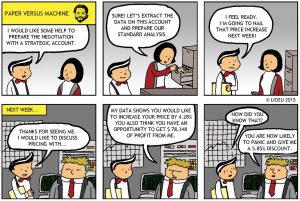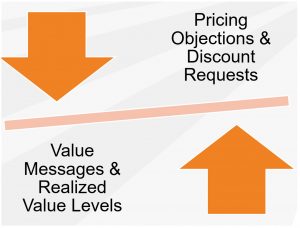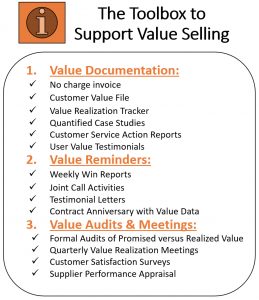Value Selling and Being Prepared for Buyers’ Tactics

The procurement function has become much more professionalized over the past decade. With the emergence of new professional purchasing practices and advanced technologies, the new generation of buyers and procurement agents are fearless. They are tech savvy, well prepared with negotiation tactics, and well-versed in the reverse engineering of value selling and value-based pricing proposals. Technologies have made their role super-efficient and focused on short-term cost savings and long-term business sustainability. Today, it is well understood that most the sales process has been replaced by advanced procurement technologies like e-cataloging, e-procurement, and marketplaces.
In 2015, I published this comic showing that data is also revolutionizing the procurement function and buyers are doing their homework. Sales reps must come prepared with rational facts and calculated delivered benefits. If not, you enter strategic negotiations at your own risk!!

It is undeniable that procurement technology will continue to evolve. What remains the same though are some aspects of the human interactions and game playing that is engrained in the purchasing process. I have read most of the value selling books out there and I listed over 20+ games that sellers must be aware of. These games are designed to destabilize the sellers, break their confidence, and obtain short-term concessions. *Here are 12 that I list in my 2016 book Dollarizing Differentiation Value:
- Playing the relationship card: “We have been friends for so many years.”
- Acting out the “pity position”: “My business is really struggling right now.”
- Taking the “my way or the highway” story: bullying and aggressiveness
- The rush and “no time to wait” position: playing you against competition.
- Taking the “I need a price now” stand: putting you in a corner with no time to prepare.
- Taking the low-ball approach: throwing low numbers and lies to see what sticks.
- Portraying the “good cop, bad cop” scenario: “Trust me, I am doing this to help you.”
- Throwing the “last minute scope change” curve ball: Re-open negotiation and try to get more.
- Adopting the scare tactic: “100% of your business is at scope and you might lose it all.”
- Playing the almighty powerful buyer: “I am calling the shots around here.”
- Playing the “white board” game: “Your competitors were just in …look!”
- The “bring-the-boss” in to get more leverage: “The CEO is coming in – it’s serious.”
- The “showing-the-fake” invoice trick: “I can prove it to you.”
- The “your quality is not to expectation” objection: Give me, give me, and give me!
- The “you’ve got to give me something” game: Everything counts!
If you are in sales, you certainly recognize some of these in your daily interactions with price buyers and other poker playing purchasing agents. The key is to recognize the games and to prepare well for them. But the combination of these games and very well-prepared buying agents is powerful. It is one of the reasons why the sales enablement and customer success functions are booming these days. It is in fact to counterbalance the power of purchasing teams. Sales teams can no longer wing it, get prepared at the last minute, rely solely on the value of the relationship, and improvise with their realized value numbers. They must respond to pricing objections and discounts requests with equally rational and hard realized value facts. They can no longer provide fuzzy numbers or high-level lists of activities they have done for customers. It is hard numbers against hard numbers!

Now, you understand why preparation and strategizing are critical part of the value selling and the negotiation process. Customer value tools are important to support the value selling process and can be brought in the process at any point in time. Your sales force must first recognize the type of accounts they are facing and them pull tools out of the toolbox as needed. A value buyer might only need to receive a customer value file or value realization report. A pure price buyer might require even less tools. A poker player might need to be convinced with more advanced tools including internal value testimonials and case studies. This is part of the sales playbook which needs to be focused on value!

A lot of the tools proposed in the value toolbox can and must be automated. It should take a few minutes and a few clicks for your sellers to produce a value realization report or a customer value journal. Having the value toolbox connected to your marketing and selling engines will give you the velocity that is needed in the SaaS world and the precision and depth that is required in the industrial and CPG sectors. Imagine your sales team fully equipped with the value tools produced in real time with the latest value data and delivered to their customers via a platform, an email, or face-to-face. It is time to consider customer value management a full fledge function and to make it as good as procurement. There is no reason not to do so. Customer value management technology is available and is getting more and more adopted. DecisionLink’s ValueCloud® is now used by hundreds of companies that are successfully producing progressive and powerful value deliverables for their customers. With the democratization of customer value management tools, we can now face the almighty powerful buyers with confidence and hard facts! That is a game changer.
Be bold. Join the customer value revolution!
Bio

Stephan Liozu (www.stephanliozu.com) is the Founder of Value Innoruption Advisors (www.valueinnoruption.com), a consulting boutique specializing in industrial pricing, digital business, and value models, and value-based pricing. Stephan has 30 years of experience in the industrial and manufacturing sectors with companies like Owens Corning, Saint-Gobain, Freudenberg, and Thales. He holds a Ph.D. In Management from Case Western Reserve University, and has written several books, including “Dollarizing Differentiation Value” (2016) and “Value Mindset” (2017).

 ValueCloud
ValueCloud
.png?width=118&height=76&name=Rectangle%20(3).png) ValueCloud Ignite
ValueCloud Ignite
.png?width=92&height=92&name=Rectangle%20(4).png) Free Assessment
Free Assessment
.png?width=100&height=100&name=Rectangle%20(5).png) Watch a Demo
Watch a Demo
.png?width=82&height=96&name=Rectangle%20(6).png) Value Calculator
Value Calculator

.png?width=62&height=51&name=Group%2010%20(1).png) Marketing
Marketing
 Sales
Sales
 Customer Success
Customer Success
 Engage Prospects
Engage Prospects
 Win Deals Faster
Win Deals Faster
 Retain Customers
Retain Customers
.png?width=62&height=62&name=Rectangle%20(8).png) Adopt and Scale
Adopt and Scale
.png?width=54&height=54&name=Rectangle%20(9).png) Cybersecurity
Cybersecurity
 Healthcare
Healthcare
.png?width=54&height=54&name=Rectangle%20(10).png) IT & Software
IT & Software



